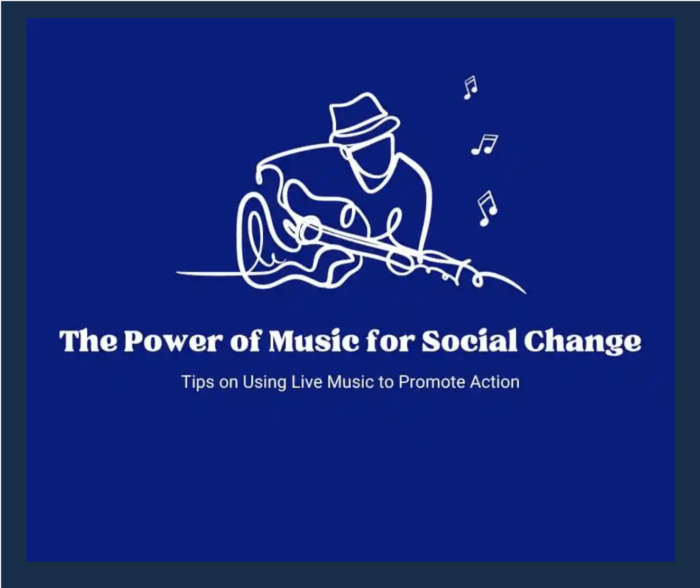Introduction
This resource is intended for musicians looking to leverage their platforms for social change, and for individual activists, grassroots activist groups and other changemakers interested in using the power of music for social change.
Songs don’t change the world, the audience does. – Billy Bragg
Quick link to access the chapter HERE

This chapter, How to Guide Your Audiences to Change the World, is from the book, Grassroots Leadership & Arts for Social Change Primers: Volume 2, edited by Susan Erenrich. It was written to document the process of testing and applying a 3 step organizing model that leverages the energy and sense of community of live musical performances. This chapter was written by founder Pete Kronowitt and other members of the Face the Music Collective. Face the Music Collective is a group of creative activists utilizing performances to inspire individual action.
” They aim to integrate creative activism with social justice advocacy, to galvanize others to become involved in the democratic process. They lead creative artists toward activism in music and across the arts.”
Face the Music Collective not only brings artists together for a cause; they also have a three-step plan for using live music to promote action. The knowledge from this chapter comes from the process of testing and applying this plan. Their goal is to leverage the immediacy, energy and spontaneity of the sense of community that results naturally from live performances.
Chapter Excerpt
3 Step Plan for Using Live Music to Promote Action
The concept is simple: after choosing a cause that speaks to you personally, identify and coordinate with one or more partner organizations for the cause you want to support; then, use your performances to engage, inspire, recruit and activate volunteers from your audiences.
To ensure our performances could have a greater impact, we developed a simple, three-step recipe:
1. Perform to support a specific cause
Structure your show(s) to set audience expectations that the performance will be utilized to support your cause.
2. Team up with a partner or partner organizations for your cause
Choose a group/groups that can help promote the show and drive attendance, as well as provide key messaging and any cause or action-related resources.
3. Provide a Call to Action
Provide an explicit call to action in your show, ideally, making the commitment as public as possible. Use a portion of your performance for a specific and meaningful call to action. The call to action should be jointly created and coordinated with your partner organization for the greatest impact. Partner organizations have the expertise and infrastructure to ensure the necessary follow-up to the audience action.
” By tapping into the large number of captive audiences at our shows, collectively, musicians can have a huge impact – even when only a small percentage of the audience members follow through on the calls to action we highlight. ”
Other Recommendations for Artists
- Measure your impact so you can establish credibility with organizations you support, and use your success to encourage other artists to make a difference.
- Use QR codes for live and online performances. For a climate change music festival, we worked with a local artist group to create large 5×5 signs with a printed QR code. A large percentage of attendees used the QR code. The QR code website links should be for either simple enrollment or one action.
- Keep the webpage succinct with limited details.
- Online shows and music videos should use calls to action with links.
- Let other artists and FtMC know what works. Experiment with your own ideas to encourage your audience to get engaged.
- Barnstorming: The idea of using calls to actions during events is not new. The organizing principle, to better utilize opportunities when people gather and then guide potential volunteers toward the highest impact actions, came from an approach called barnstorming. Barnstorming is a longstanding tactic of grassroots activists that was optimized during the 2016 Bernie Sanders campaign. Barnstorming can be used in every gathering, whether small events or larger marches. The objective of barnstorming is to get volunteers to take immediate action(s), not to educate people on the issues. It is a replicable tool for putting people to work on valuable tasks that will help execute a strategy. Barnstorming takes advantage of the dynamics of people attending an event, and guides them to take a specific action by building community in the room. Face the Music Collective has used barnstorming to get new folks involved in campaigns targeting friends of engaged volunteers. You can find more information about barnstorming in the book Rules for Revolutionaries (2016) by Becky Bond and Zack Exley.
- Organize a music or cultural event that kicks off a week of action.
” As artists, we create moments that move our audiences emotionally. We could easily use that momentum to encourage people to take specific, well-defined actions that lead to real solutions. ”
Credit
Pete Kronowitt and other members of the Face the Music Collective
